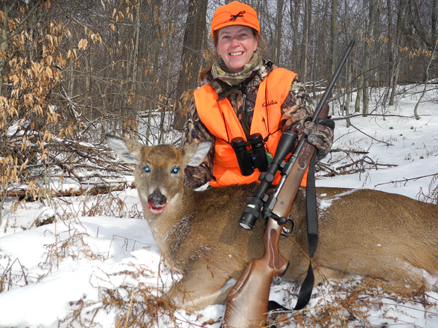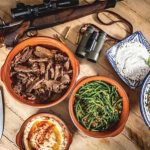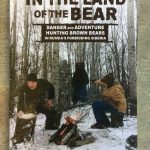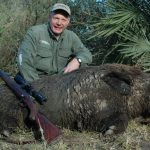It’s time to welcome a new generation of health-conscious meat-eaters into the world of hunting.
Photo above: Rupp with some steaks and roasts she procured in Pennsylvania last fall (still in their original packaging).
Years before I got my first hunting license at the age of twelve, I was–at least in my own young mind–a crucial part of the process of putting our family’s yearly venison in the freezer. It was my job, you see, to wrap. As Mom and Dad cut up their deer into steaks, chops, and roasts, I’d sit next to them with my trusty plastic wrap, freezer paper, tape, and Sharpie. First I’d wrap the meat tightly in plastic wrap, making sure no air was left inside. The thick, white freezer paper went on next (Mom showed me how to do the cool-looking butcher’s fold), and I’d tape it down securely. Next, I’d write with the marker whether it was Mom’s or Dad’s deer, the cut, and the date, and embellish the package with little drawings of deer.
Fast-forward thirty-some years to southern California, where an eclectic group of friends gathers on our back patio while my husband grills up elk and moose backstraps from our freezer. I’ve long since traded the paper and tape for a Foodsaver and abandoned my nascent career as an artist, but I still love the whole process of turning a game animal into a delicious meal. Even more, I enjoy the comments from my nonhunting friends: “This is delicious!” “Hey, I thought it would be gamey!” “Sure, I’ll have seconds!”
Popular interest in wild game as a food source has undergone a meteoric rise lately, fueled by bestselling books by the likes of vegan-turned-hunter Tovar Cerulli (The Mindful Carnivore) and celebrity chef Georgia Pellegrini (Girl Hunter), as well as articles such as “Hipsters Who Hunt: More Liberals Are Shooting Their Own Supper” on Slate.com.
All this is great news for hunting. As I know from those backyard wild-game barbecues, people who are not otherwise favorably disposed to the idea of killing an animal turn out to be fine with it if they get to eat it and it tastes good.
In fact, some experts say this phenomenon is bringing a whole new demographic of health-conscious and environmentally ethical adults into the ranks of hunters. That’s right; hunting (for food, at least) is becoming–gasp–hip! And why not? Wild game is healthy, low-cholesterol, lean protein with no added hormones or antibiotics. In a recent survey, Responsive Management reported that 68 percent of hunters surveyed identified obtaining local, natural, or “green” food as an influence in their decision to hunt.
State wildlife agencies aren’t ignoring this trend. For the first time since the 1980s, resident hunting license sales are on the rise, and some wildlife managers are crediting the increasing interest of young urbanites in eating wild food as at least a partial driver of thhis participation. They’re responding by reaching out to this demographic with new programs like “Hunt, Fish, Eat,” a food-centered adult hunter ed program offered by the Indiana DNR, and “Gourmet Gone Wild,” a program started by the Michigan DNR in partnership with Michigan State University and the Boone and Crockett Club.
Talking about memorable wild-game meals takes me back to a camp in the Yukon wilderness several years ago where sheep backstraps were sizzling in a pan on a camp stove. I had just pulled an exhausting all-nighter helping my guide pack out my magnificent Dall sheep. As I sat there, tired and hungry, salivating as the meat cooked, I considered the complicated truth about hunting: The sustenance we ultimately derive from the chase is as much spiritual and emotional as it is physical, but it all began, long ago, because we needed to eat. And we still do.











